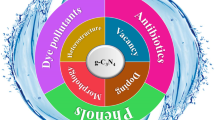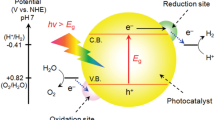Abstract
In this work, nickel sulfide (NiS)/bismuth oxybromide (BiOBr) hybrids were synthesized by a two-step hydrothermal method. Some advanced tools were employed to characterize the crystal phase, morphological evolution, light absorption and photocatalytic performance. Significantly, NiS/BiOBr hybrids exhibited enhanced photocatalytic activity toward rhodamine B (RhB) degradation under visible light irradiation. Comparatively, NS/BOB-3.0 showed the highest degradation rate, over 2.5 times higher than that of pure BiOBr. Furthermore, the retarded recombination rate of photogenerated carriers contributed to the improved photocatalytic performance. The results indicate that hybrids may be a promising method for enhancing the photocatalytic ability of BiOX-based semiconductor.













Similar content being viewed by others
References
Pomilla FR, Cortes MALRM, Hamilton JWJ, Molinari R, Barbieri G, Marcì G, Palmisano L, Sharma PK, Brown A, Byrne JA (2018) An investigation into the stability of graphitic C3N4 as a photocatalyst for CO2 reduction. J Phys Chem C 122:28727–28738
Yuan M, Tian F, Li G, Zhao H, Liu Y, Chen R (2017) Fe(III)-modified BiOBr hierarchitectures for improved photocatalytic benzyl alcohol oxidation and organic pollutants degradation. Ind Eng Chem Res 56:5935–5943
Yadav M, Garg S, Chandra A, Hernadi K (2019) Fabrication of leaf extract mediated bismuth oxybromide/oxyiodide (BiOBrxI1 − x) photocatalysts with tunable band gap and enhanced optical absorption for degradation of organic pollutants. J Colloid Interface Sci 555:304–314
Li J, Yang F, Zhou Q, Ren R, Wu L, Lv Y (2019) A regularly combined magnetic 3D hierarchical Fe3O4/BiOBr heterostructure: fabrication, visible-light photocatalytic activity and degradation mechanism. J Colloid Interface Sci 546:139–151
Yadav M, Garg S, Chandra A, Hernadi K (2019) Immobilization of green BiOX (X = Cl, Br and I) photocatalysts on ceramic fibers for enhanced photocatalytic degradation of recalcitrant organic pollutants and efficient regeneration process. Ceram Int 45:17715–17722
Liu H, Zhou H, Liu X, Li H, Ren C, Li X, Li W, Lian Z, Zhang M (2019) Engineering design of hierarchical g-C3N4@Bi/BiOBr ternary heterojunction with Z-scheme system for efficient visible-light photocatalytic performance. J Alloy Compd 798:741–749
Sotelo-Vazquez C, Quesada-Cabrera R, Ling M, Scanlon DO, Kafizas A, Thakur PK, Lee TL, Taylor A, Watson GW, Palgrave RG, Durrant JR, Blackman CS, Parkin IP (2017) Evidence and effect of photogenerated charge transfer for enhanced photocatalysis in WO3/TiO2 heterojunction films: a computational and experimental study. Adv Funct Mater 27:1605413–1645422
Adhikari SP, Hood ZD, More KL, Chen VW, Lachgar A (2016) A visible-light-active heterojunction with enhanced photocatalytic hydrogen generation. ChemSusChem 9:1–12
Xia J, Ge Y, Zhao D, Di J, Ji M, Yin S, Li H, Chen R (2015) Microwave-assisted synthesis of few-layered MoS2/BiOBr hollow microspheres with superior visible-light-response photocatalytic activity for ciprofloxacin removal. CrystEngComn 17:3645–3651
Wu Z, Liu J, Tian Q, Wu W (2017) Efficient visible light formaldehyde oxidation with 2D p-n heterostructure of BiOBr/BiPO4 nanosheets at room temperature. ACS Sustain Chem Eng 5:5008–5017
Liu H, Du C, Li M, Zhang S, Bai H, Yang L, Zhang S (2018) One-pot hydrothermal synthesis of SnO2/BiOBr heterojunction photocatalysts for the efficient degradation of organic pollutants under visible light. ACS Appl Mater Interface 10:28686–28694
Yang L, Liang L, Wang L, Zhu J, Gao S, Xia X (2019) Accelerated photocatalytic oxidation of carbamazepine by a novel 3D hierarchical protonated g-C3N4/BiOBr heterojunction: Performance and mechanism. Appl Surf Sci 473:527–539
Kanagaraj T, Thiripuranthagan S (2017) Photocatalytic activities of novel SrTiO3–BiOBr heterojunction catalysts towards the degradation of reactive dyes. Appl Catal B Environ 207:218–232
Pálmai M, Zahran EM, Angaramo S, Bálint S, Pászti Z, Knecht MR, Bachas LG (2017) Pd-decorated m-BiVO4/BiOBr ternary composite with dual heterojunction for enhanced photocatalytic activity. J Mater Chem A 5:529–534
Allagui L, Chouchene B, Gries T, Medjahdi G, Girot E, Framboisier X, Amara AB, Balan L, Schneider R (2019) Core/shell rGO/BiOBr particles with visible photocatalytic activity towards water pollutants. Appl Surf Sci 490:580–591
Zhou X, Sun H, Zhang H, Tu W (2017) One-pot hydrothermal synthesis of CdS/NiS photocatalysts for high H2 evolution from water under visible light. Int J Hydrogen Energy 42:11199–11205
Zhao H, Zhang H, Cui G, Dong Y, Wang G, Jiang P, Wu X, Zhao N (2018) A photochemical synthesis route to typical transition metal sulfides as highly efficient cocatalyst for hydrogen evolution: from the case of NiS/g-C3N4. Appl Catal B Environ 225:284–290
Zhang Y, Zuo L, Zhang L, Yan J, Lu H, Fan W, Liu T (2016) Immobilization of NiS nanoparticles on N-doped carbon fiber aerogels as advanced electrode materials for supercapacitors. Nano Res 9:2747–2759
Zhu S, Qi Q, Fang Y, Zhao W, Wu M, Han L (2018) Covalent triazine framework modified BiOBr nanoflake with enhanced photocatalytic activity for antibiotic removal. Cryst Growth Des 18:883–891
Hu M, Yan A, Wang X, Huang F, Cui Q, Li F, Huang J (2019) Hydrothermal method to prepare Ce-doped BiOBr nanoplates with enhanced carrier transfer and photocatalytic activity. Mater Res Bull 116:89–97
Kong XY, Lee WPC, Ong WJ, Chai SP, Mohamed AR (2016) Oxygen-deficient BiOBr as a highly stable photocatalyst for efficient CO2 reduction into renewable carbon-neutral fuels. ChemCatChem 8:1–9
Xue C, Zhang T, Ding S, Wei J, Yang G (2017) Anchoring tailored low-index faceted BiOBr nanoplates onto TiO2 nanorods to enhance the stability and visible-light-driven catalytic activity. ACS Appl Mater Interfaces 9:16091–16102
Zhang J, Lv J, Dai K, Liang C, Liu Q (2018) One-step growth of nanosheet-assembled BiOCl/BiOBr microspheres for highly efficient visible photocatalytic performance. Appl Surf Sci 430:639–646
Wang D, Shen H, Guo L, Wang C, Fu F (2016) Porous BiOBr/Bi2MoO6 heterostructures for highly selective adsorption of methylene blue. ACS Omega 1:566–577
Liu M, Chen Y, Su J, Shi J, Wang X, Guo L (2016) Photocatalytic hydrogen production using twinned nanocrystals and an unanchored NiSx co-catalyst. Nat Energy 1:16151
Kim SY, Gopi CVVM, Reddy AE, Kim HJ (2018) Facile synthesis of a NiO/NiS hybrid and its use as an efficient electrode material for supercapacitor applications. New J Chem 42:5309–5313
Li Q, Guo J, Xu D, Guo J, Qu X, Hu Y, Qi H, Yan F (2018) Electrospun N-doped porous carbon nanofibers incorporated with NiO nanoparticles as free-standing film electrodes for high-performance supercapacitors and CO2 capture. Small 14:1704203–1704214
Qu X, Liu M, Li L, Wang R, Sun H, Shi L, Du F (2019) BiOBr flakes decoration and structural modification for CdTe/TiO2 spheres: towards water decontamination under simulated light irradiation. Mater Sci Semicond Process 93:331–338
Xue X, Chen R, Chen H, Hu Y, Ding Q, Liu Z, Ma L, Zhu G, Zhang W, Yu Q, Liu J, Ma J, Jin Z (2018) Oxygen vacancy engineering promoted photocatalytic ammonia synthesis on ultrathin two-dimensional bismuth oxybromide nanosheets. Nano Lett 18:7372–7377
Ruan Y, Zha D, Lv L, Zhang B, Liu J, Ji X, Wang C, Jiang J (2017) Al-doped β-NiS mesoporous nanoflowers for hybrid-type electrodes toward enhanced electrochemical performance. Electrochim Acta 236:307–318
Zhou S, Huang Y, Xu L, Zheng W (2018) Microwave-assisted synthesis of graphene-NiS/Ni3S2 composites for enhanced microwave absorption behaviors through a sulfuration method. Ceram Int 44:21786–21793
Zhao G, Liu L, Li C, Zhang T, Yan T, Yu J, Jiang X, Jiao F (2018) Construction of diatomite/ZnFe layered double hydroxides hybrid composites for enhanced photocatalytic degradation of organic pollutants. J Photochem Photobiol A 367:302–311
Bo J, Li J (2015) Controlled preparation of porous TiO2–Ag nanostructures through supramolecular assembly for plasmon-enhanced photocatalysis. Adv Mater 27:314–319
Babar S, Gavade N, Shinde H, Mahajan P, Lee KH, Mane N, Deshmukh A, Garadkar K, Bhuse V (2018) Evolution of waste iron rust into magnetically separable g-C3N4-Fe2O3 photocatalyst: an efficient and economical waste management approach. ACS Appl Nano Mater 1:4682–4694
Khan UA, Liu J, Pan J, Zuo S, Ma H, Yu Y, Ahmad A, Ullah S, Li B (2018) One step fabrication of novel Ag-CdS@EP floating photocatalyst for efficient degradation of organic pollutants under visible light illumination. Dalton Trans 47:12253–12263
Fu S, Liu X, Yan Y, Li L, Liu H, Zhao F, Zhou J (2019) Few-layer WS2 modified BiOBr nanosheets with enhanced broad-spectrum photocatalytic activity towards various pollutants removal. Sci Total Environ 694:133756–133768
Lu L, Xu X, An K, Wang Y, Shi F (2018) Coordination polymer derived NiS@g-C3N4 composite photocatalyst for sulfur vacancy and photothermal effect synergistic enhanced H2 production. ACS Sustain Chem Eng 6:11869–11876
Wang J, Wang G, Wei X, Liu G, Li J (2018) ZnO nanoparticles implanted in TiO2 macrochannels as an effective direct Z-scheme heterojunction photocatalyst for degradation of RhB. Appl Surf Sci 456:666–675
Li Y, Ouyang S, Xu H, Wang X, Bi Y, Zhang Y, Ye J (2016) Constructing solid-gas-interfacial fenton reaction over alkalinized-C3N4 photocatalyst to achieve apparent quantum yield of 49% at 420 nm. J Am Chem Soc 138:13289–13297
Bagheri M, Masoomi MY, Morsali A (2017) A MoO3-metal-organic framework composite as a simultaneous photocatalyst and catalyst in the PODS process of light oil. ACS Catal 7:6949–6956
Duo F, Wang Y, Mao X, Fan C, Zhang H (2014) Double Br sources fabrication and photocatalytic property of p-n junction BiOBr/ZnO composites for phenol removal. Cryst Res Technol 49:721–730
Majhi D, Samal PK, Das K, Gouda SK, Bhoi YP, Mishra BG (2019) α-NiS/Bi2O3 nanocomposites for enhanced photocatalytic degradation of tramadol. ACS Appl Nano Mater 2:395–407
Acknowledgements
The work was financially supported by the Fundamental Research Funds for the Central Universities (2017XKQY010).
Author information
Authors and Affiliations
Corresponding authors
Additional information
Publisher's Note
Springer Nature remains neutral with regard to jurisdictional claims in published maps and institutional affiliations.
Rights and permissions
About this article
Cite this article
Hu, M., Yan, A., Cui, Q. et al. NiS/BiOBr hybrids with retarded carrier recombination and enhanced visible-light-driven photocatalytic activity. J Mater Sci 55, 4265–4278 (2020). https://doi.org/10.1007/s10853-019-04288-9
Received:
Accepted:
Published:
Issue Date:
DOI: https://doi.org/10.1007/s10853-019-04288-9




